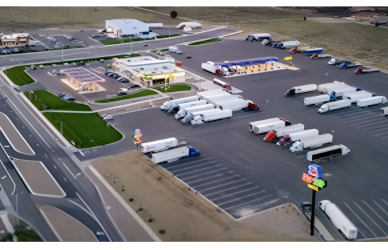With rising costs and sluggish demand, the freight market is facing a challenging future. Experts predict modest growth throughout 2024, placing the economy’s stability at the forefront of critical concerns in the trucking industry. Amidst this uncertainty, there is an opportunity for small-midsize carriers to leverage technology and fortify their operations for a successful rebound.
According to industry leaders, investing in technology during a slow economy is key to preparing for a stronger comeback. Companies can optimize their operations, improve efficiency, and drive growth regardless of market volatility.
BlueGrace Logistics Chief Technology Officer, Azad Ratzki, suggests three vital technologies that can empower carriers to not only survive a bearish economy but also thrive in a bullish one: large language models (LLMs), freight optimization platforms, and no-code automation.
“By using LLMs such as OpenAI’s ChatGPT for communications, freight optimization strategies employing the use of pooling, and the automation of repetitive processes using the variety of no-code options available on the market, there has never been a better time to revisit and reevaluate the way organizations operate,” Ratzki said. “While some processes may be tried and true, a bearish market is vitally important to the growth of the economy, helping driving innovation and finding new, untapped opportunities in a more constrained environment. All three of these technologies have the power to radically transform the way businesses perform.”
Boost Efficiency and Enhance Human Tasks with LLMs
LLMs can help your business by automating certain tasks, allowing your team to focus on what really matters. With LLMs, you can streamline communication, harnessing the subtleties of human nature in every interaction.
With LLMs, you can streamline person-to-person interaction without losing the essence of human nature. From obtaining status updates from partners to answering frequently asked questions, LLMs can handle it all while maintaining a personal touch.
While chatbots have been around for a while, recent advancements in artificial intelligence, such as ChatGPT, have taken this technology to new heights. Now, more people than ever are realizing the potential of LLMs.
Don’t think this technology is just for big players. Even smaller carriers can benefit from off-the-shelf LLM products readily available on the market.
Simplify and Streamline Your Processes with Automation Platforms
According to Ratzki, carriers can streamline repetitive tasks by taking advantage of the wide range of user-friendly automation platforms now available. These platforms, such as Google Workflows and Microsoft Power Automate, empower carriers to seamlessly connect and automate various systems without the need for coding skills. By leveraging these platforms, carriers can effortlessly integrate data from emails and forms to create efficient automations, all without having to write a single line of code.
In addition, Ratzki drew parallels between this conversation and LLM, emphasizing the importance of simplifying and optimizing processes through automation.
“You’re looking at it from the perspective of here’s what I have to do, and I end up doing it many times over and over again every single day,” Ratzki said. “How do I streamline that? How do I automate that so that someone can be freed up to go do something that is more important or even more profitable? Any process that involves computers in your organization is now an ideal candidate for automation through these platforms.”
Unlock Exponential Growth with Optimization Platforms
Optimization platforms allow organizations to pool their freight, resulting in significant time and cost savings.
By seamlessly integrating with 3PL platforms, carriers can achieve remarkable efficiency. Automatic load feeding and real-time tracking are just some of the cost-effective measures that can elevate your operations to new heights.
“You want to reduce as much friction as possible, and what I mean by friction, if you’re looking at it from a carrier perspective, you want those volumes to come to you, especially in this sort of economy. You want all barriers for potential customers of your services to be removed,” Ratzki said.
Ratzki claims that this technology is both easy to use and cost-effective for smaller carriers. He highlights that it can serve as a protective measure against economic downturns by eliminating the need for actively seeking out new business opportunities.
“Whether you realize it or not, if you’re that smaller carrier, when an integration is in place, business is transacting without your intervention in any way, shape or form,” he said. “It’s basically doing business without even having to really talk about it, so you’re just becoming part of a larger broader feeder network.”
According to Ratzki, smaller carriers don’t need to start with a huge investment to reap the rewards. Whether you’re a big player or a small fry, these three technologies are accessible and affordable for carriers of any size.
The majority of these technologies are offered as software subscriptions, making them cost-effective as your business grows. Ratzki suggests taking advantage of a free trial or signing up for a low-cost monthly subscription to test drive the benefits before fully committing.
“You don’t have to be a software engineer or technologist to really leverage these things. But once you start experimenting with them, you can quickly see the value,” he said. “I think if you’re small to medium, you’re still a very blank canvas from a technology perspective so there should be relatively no barriers.
“The smaller you are, the less capital you have to work with obviously, but in terms of non-capital-related barriers for small and medium business, you should be pretty free and clear to experiment with some of these things,” he added. “I think with the larger carriers, the conversation changes because typically you already have a large amount of technology infrastructure, so then it becomes a discovery of how do I weave this into my current technology stack; that becomes the barrier to entry.”
Source: CCJ Digital











